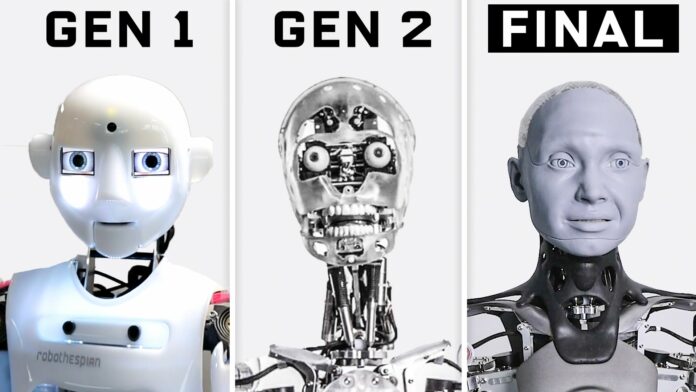In the realm of technological advancement, humanoid robots stand as a testament to the remarkable fusion of artificial intelligence and mechanical engineering. These anthropomorphic creations, often referred to as androids, embody the pursuit of creating machines that mimic human form and behavior. This article delves into the captivating world of humanoid robots, exploring their evolution, cutting-edge advancements, challenges, and the unfolding potential they hold in reshaping industries and human interaction.
Introduction to Humanoid Robots
Defining Humanoid Robots
Humanoid robots are machines designed to resemble the human form and exhibit human-like behaviors. These robots are equipped with advanced mechanical and electronic components that enable them to imitate human movements, gestures, and interactions. Humanoid robots aim to replicate not only the physical appearance but also the cognitive and emotional aspects of human beings.

From Science Fiction to Reality
The concept of humanoid robots has long captivated human imagination through science fiction literature, movies, and art. However, recent advancements in robotics, artificial intelligence, and materials science have transformed this once-fanciful notion into a tangible reality. Today, humanoid robots inhabit research labs, industries, and even our daily lives, pushing the boundaries of what machines can achieve.
The Mechanics of Humanoid Robotics
Biomimicry and Human Inspiration
The design of humanoid robots draws inspiration from the human musculoskeletal system and biomechanics. Engineers and researchers study human anatomy to create robots with limbs, joints, and movements that closely resemble those of humans. This biomimicry enables humanoid robots to perform tasks that require dexterity, agility, and balance.
Actuators, Sensors, and Kinematics
Humanoid robots are equipped with specialized actuators, such as motors and servos, that replicate human joint movements. These actuators work in tandem with sensors, including accelerometers, gyroscopes, and tactile sensors, to provide feedback and enable precise control. Kinematics, the study of motion, plays a pivotal role in programming humanoid robots to execute fluid and lifelike movements.
Stay tuned as we delve into the progress made in artificial intelligence, enabling humanoid robots to think, learn, and interact.
Progress in Artificial Intelligence
Cognitive Abilities and Learning
Artificial intelligence is at the core of humanoid robots’ ability to mimic human behaviors and cognition. Machine learning algorithms enable robots to process sensory inputs, recognize patterns, and adapt their actions based on the environment. As a result, humanoid robots can learn from experience, make decisions, and refine their performance over time.
Emotion Recognition and Interaction
Advancements in AI have paved the way for humanoid robots to recognize and respond to human emotions. Facial recognition software, coupled with natural language processing, allows these robots to engage in emotionally intelligent interactions. This capability holds great potential for applications in healthcare, therapy, and companionship.
Applications of Humanoid Robots
Assistive Technologies and Healthcare
Humanoid robots are making significant contributions in healthcare and assistive technologies. These robots can assist individuals with limited mobility, provide physical therapy, and even serve as companions for the elderly. Their human-like attributes foster a sense of trust and comfort, making them valuable assets in improving quality of life.
Education, Entertainment, and Beyond
In the realm of education, humanoid robots act as engaging and interactive instructors. They can teach various subjects, languages, and skills to learners of all ages. Additionally, humanoid robots are finding roles in entertainment, performing tasks such as dancing, acting, and interacting with audiences in ways that captivate and entertain.
Challenges and Ethical Considerations
Human-Like Dexterity and Mobility
While humanoid robots have made remarkable strides, achieving human-like dexterity and mobility remains a challenge. The complexity of replicating the intricate movements and fine motor skills of humans presents a technological hurdle that researchers are diligently working to overcome.
Human-Robot Interaction Ethics
The integration of humanoid robots into human environments raises ethical considerations surrounding their role and impact. Questions about privacy, consent, job displacement, and the potential blurring of human-robot boundaries warrant careful examination and responsible development.
The Future of Humanoid Robots
Enhancing Human Lives and Industries
The future of humanoid robots holds the promise of transforming various industries and augmenting human capabilities. In healthcare, they could assist in surgeries and rehabilitation. In industries like manufacturing and logistics, humanoid robots could perform tasks that are hazardous or repetitive for humans. Moreover, these robots may play a vital role in space exploration, disaster response, and scientific research.
Conclusion
Humanoid robots epitomize the convergence of technological innovation and human ingenuity, bridging the gap between the mechanical and the sentient. As we continue to push the boundaries of what is possible, these lifelike androids have the potential to reshape industries, enhance human well-being, and even redefine our understanding of consciousness. The journey towards lifelike machines is one marked by challenges and ethical considerations, but it is also a journey that holds the promise of unlocking new frontiers of human-machine collaboration.
FAQs
Q1: How do humanoid robots differ from other types of robots?
A: Humanoid robots are designed to resemble the human form and exhibit human-like behaviors, while other robots may have different forms and functions.
Q2: What is the significance of biomimicry in humanoid robot design?
A: Biomimicry allows humanoid robots to replicate human movements and behaviors, enabling them to perform tasks that require human-like dexterity and mobility.
Q3: How do humanoid robots recognize human emotions?
A: Humanoid robots recognize human emotions through facial recognition software, voice analysis, and natural language processing algorithms.
Q4: What are some potential ethical concerns surrounding humanoid robots?
A: Ethical concerns include issues of privacy, consent, job displacement, and blurring the boundaries between humans and machines.
Q5: How might humanoid robots contribute to space exploration and scientific research?
A: Humanoid robots could assist in tasks such as maintenance, exploration, and data collection in environments that are challenging or hazardous for humans, such as space exploration and deep-sea research.


